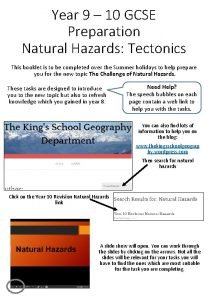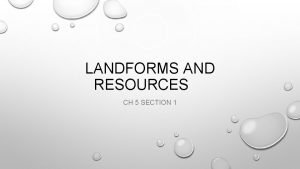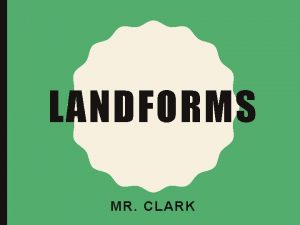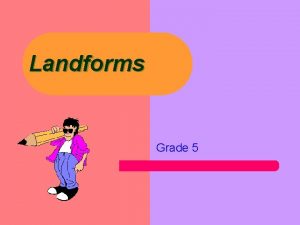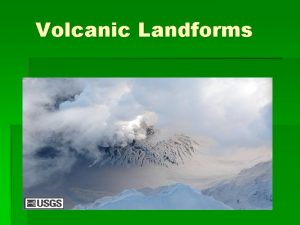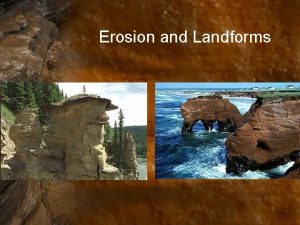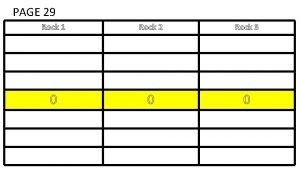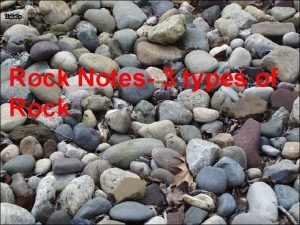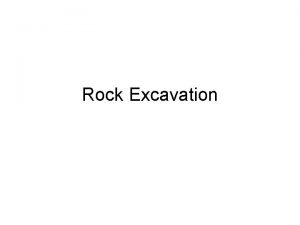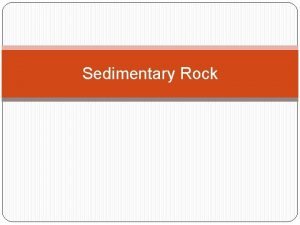TECTONIC FORCES ROCK STRUCTURE AND LANDFORMS Tectonic forces




















- Slides: 20

TECTONIC FORCES, ROCK STRUCTURE AND LANDFORMS

Tectonic forces �The forces can affect the earth at different scale �Continental, regional and even local �Might cause bending, warping, folding and fracturing �Three types of Tectonic forces (Earth movements) �(i) Compressional force �(ii) Tensional forces �(iii) Shearing forces

Compressional Tectonic Forces � Push � It two areas of crustal rocks together shorten and thicken the crust � Impact on rocks will depend on (a) brittleness (breakable and (b) speed applied � RESULTING PROCCES OF COMPRESSION the following are the resulting process of compression


A. Folding � When compressional force is applied to ductile rocks and at slow speed Folds in rocks in Nunavut, Canada Folds in rocks in Crete, Greece.

Types of Folds � Anticlines-Upturned folds-is a fold that arches up as both sides of the rock are pushed inward � Synclines -down turned folds is a fold that sinks down as both sides of the rock are pushed inward. � Anticlines and synclines are geologic structures, that is, they are folds in rock material. � Monoclines -rock layers form an S-shape as the sides of the rock are compressed � Domes -are like anticlines but instead of an arch, the fold is in a dome shape, like an inverted bowl. � Basins-are like synclines but again, instead of a sinking arch, the fold is in a shape of a bowl sinking down into the ground.

Components of a Fold

Classification of Folds � 1. Symmetrical folds (Simple/normal folds) -have near-vertical axial planes - gently dipping limbs of about the same angle -product of gentle compression. -Found near mountain margins � 2. Asymmetrical -the axial plane is inclined -limbs are unequal in length

Overturn Folds � Occurs when the compression is more pronounced from one direction � the axial plane is tilted and beds may dip in same direction on both sides of the axial plane.

Recumbent Produced when an extreme directed pressure lay the fold over with its axial plane nearly horizontal

Plunging Folds: occur when the length of the folds are tilted creating plunging folds.


Faulting � Is the slippage/displacement of rocks along a fracture surface �A fault is a fracture along which the movement has occurred � When compressional forces cause faulting either (i) one mass of rock is pushed up along a steep-angled fault relative to the other-Reverse fault � (ii) or one mass of rock slides along a shallow, low-angle fault over the other-thrust fault and the shallow displacement is an overthrust

�It is difficult to determine whether both blocks moved �Reverse and thrust faults also occur when compressional forces are applied rapidly or to rocks that have already responded to folding �Good example of overthrust faults occur along the southern Appalachian mountains

Tensional Forces and Faulting � Pull in opposite directions � Stretches � Rock � The and thins the impacted part of the rock crust respond by faulting rather that bending or stretching plastically crust breaks into discrete blocks called fault blocks separated by Normal fauts

� Tensional forces may affect large regions causing a repeated pattern of alternating downdropped and upthrown fault blocks � Graben-downward slid of a block between two normal faults or the stationary block when two blocks on either side moved upward � Horst-movement of fault block upward between two normal faults or remained in place while two adjacent blocks moved downward � Host and Graben are rock structural features � Topographically basins horsts form mountain ranges and grabens form


� Fault scarps (Escarpments) – a cliff resulting from movement along a fault � Piedmond fault scarp- vertical offsetting of unconsolidated sediments at the base of an escarpment


Shearing tectonic forces � Lateral faults-Horizontal displacement rather than vertical � The slippage is parallel to the surface trace, or strike of the fault � Strike slip faults cause horizantal displacement of roads , railway tracks, fences , streams and other features
 Igneous and metamorphic
Igneous and metamorphic A rock climber's shoe loosens a rock and her climbing buddy
A rock climber's shoe loosens a rock and her climbing buddy Chapter 3 standardized test practice answers
Chapter 3 standardized test practice answers Rock cycle
Rock cycle Igneous rock to metamorphic rock
Igneous rock to metamorphic rock Adventure sports bungee jumping
Adventure sports bungee jumping Rock cycle diagram class 7
Rock cycle diagram class 7 What is like parallel force
What is like parallel force Contact vs noncontact forces
Contact vs noncontact forces Force examples in everyday life
Force examples in everyday life Is erosion a constructive force
Is erosion a constructive force Primary and secondary effects of a tectonic hazard
Primary and secondary effects of a tectonic hazard Primary volcanic hazards
Primary volcanic hazards The forces shown above are
The forces shown above are Intermolecular vs intramolecular forces
Intermolecular vs intramolecular forces Intermolecular forces in a lava lamp
Intermolecular forces in a lava lamp Intramolecular forces vs intermolecular forces
Intramolecular forces vs intermolecular forces Chapter 24 section 1 landforms and resources
Chapter 24 section 1 landforms and resources Landforms of the southwest
Landforms of the southwest Chapter 5 section 1 landforms and resources
Chapter 5 section 1 landforms and resources Types of landforms
Types of landforms











